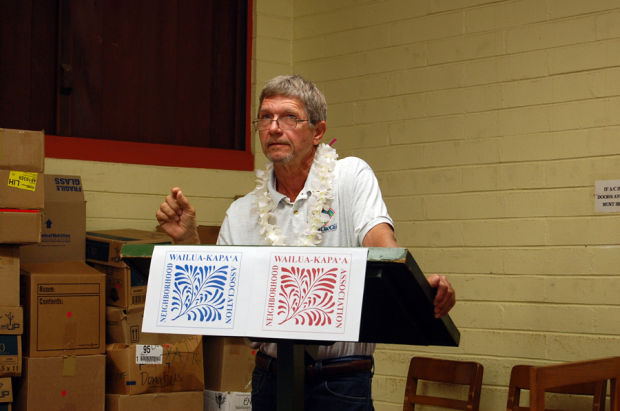KAPA‘A — The mantra Jerry Ornellas wants people to remember is “10 by 20.” Ornellas, a fourth-generation farmer and president of the Kaua‘i County Farm Bureau, hopes to realize a 10 percent increase in agricultural production in the state by
KAPA‘A — The mantra Jerry Ornellas wants people to remember is “10 by 20.”
Ornellas, a fourth-generation farmer and president of the Kaua‘i County Farm Bureau, hopes to realize a 10 percent increase in agricultural production in the state by 2020.
Speaking to the Wailua-Kapa‘a Neighborhood Association about moving Hawai‘i toward food self-sufficiency Saturday, Ornellas said $1.3 billion leaves Hawai‘i annually — a figure on par with oil sales — in sales of food, much of which can be grown here.
“We import food and export dollars,” he said to a room filled with more than 50 people at the Kapa‘a Library. Ornellas said increasing local food production by just 10 percent would mean an additional $300 million in revenue for the state and $31.3 million annually for Kaua‘i.
Ornellas said the problems started around 1980 when “ag went off a cliff,” in the state.
“It literally fell off the cliff” with the demise of pineapple and sugar crops, he said.
Before then, “the Neighbor Islands fed Honolulu,” he said.
For decades, the Neighbor Islands would grow fruits and veggies and the surplus would be sent to O‘ahu.
He praised Gov. Neil Abercrombie’s “Food Security and Food Self-sufficiency Strategy” initiative.
“It’s extremely positive what he’s done,” Ornellas said noting that it’s extremely rare to get such an initiative from the governor’s office. “If we don’t respond enthusiastically, we may not get the offer again. We must take up the challenge.”
The state’s strategy has three objectives: increase demand for and access to locally grown food; increase production and locally grown foods; and provide policy and organizational support to meet food self-sufficiency needs.
In order to meet those objectives, Ornellas said that financially it is better for small farmers to own their land outright, even if it is a small plot.
“The best stewards of the land are people who own their own land,” he said.
As for plot size, Ornellas noted that 80 percent of the producers of the 1,800 farm bureau members produce their goods on two acres or less.
One audience member asked about the possibility of growing hemp to “remediate the land.”
Ornellas said that at least 1,500 products could be made from commercial hemp and questioned how a plant could be illegal. Ornellas said many plants — such as neem — are toxic, but even those plants weren’t illegal.
He lamented the fact that farmers today are unable to make a living in their profession, noting that farmers need to gross at least $100,000 to make just $30,000 annually.
To that end, he lamented never seeing a business plan from a farmer.
“You need to do your homework and do your marketing and research,” Ornellas said.
The “gutting by the Legislature” of the College of Tropical Agriculture and Human Resources at the University of Hawai‘i has led to a lack of statisticians that are greatly needed to conduct base line studies, he added.
A recent public meeting at Kaua‘i Community College, Helen Cox, chancellor of KCC, called for more students to learn the business of agriculture, in addition to the hands-on aspects of it in hopes of helping future ag producers make a living in the profession.
Ornellas said he has “lots of respect” for Cox and her efforts to increase agriculture offerings.
He also called for increasing access to technology in order to save various resources.
“If you want to save the world, make things obsolete,” Ornellas said, noting how whale oil production became obsolete with the invention of kerosene, thus saving the lives of whales.
Ornellas also spoke to the idealism of being a producer.
“You can’t find a better livelihood than farming if you’re a surfer and you have time for the arts, that’s why they call it ‘agriculture,’” he said in a bid to encourage younger people to enter the profession.
Currently, for every dollar spent on food, Ornellas said, a farmer keeps only 18 cents, which often lands them in poverty that is often just accepted because producers love what they do.
However, Ornellas emphasized a paradigm shift is in order to “get people to buy our goods.”
Read more about the recent report published jointly by the state Office of Planning and the Hawai‘i Department of Agriculture titled, “Increased Food Security and Food Self-sufficiency Strategy.” The 47-page report is available online at http://hawaii.gov/hdoa/planning/increased-food-security-and-food-self-sufficiency-strategy and sets forth objectives, policies and actions to increase the amount of locally grown food consumed by Hawai‘i residents.


